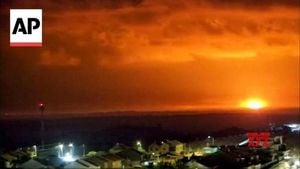On a crisp September morning in Eastern Europe, military officials and journalists gathered near a Belarusian training ground, their attention fixed on a spectacle that has sent ripples through capitals from Warsaw to Washington. The Zapad 2025 military exercises, a sweeping display of Russian and Belarusian might, have drawn in not only local onlookers but also international observers—most notably, a contingent from the United States. For the first time since Russia’s 2022 invasion of Ukraine, U.S. military officials attended these joint war games, marking a moment that is as symbolic as it is strategic.
According to the Associated Press, the Zapad 2025 drills involved about 100,000 troops and 10,000 combat vehicles and weapons systems, stretching across 41 training grounds. The exercises, which concluded on September 16, 2025, included live fire, drone air strikes, mobile fire groups on motorcycles and buggies, air defense support, and even the evacuation of wounded soldiers using robotic vehicles. The sheer scale of the event was intended to showcase the readiness and technological prowess of the Russian and Belarusian militaries.
But it was the presence of U.S. personnel, including Air Force Lt. Col. Bryan Shoupe, that raised eyebrows. As Reuters reported, these American officers attended the drills as part of the Distinguished Visitor Day, following an invitation extended to the U.S. Embassy in Minsk. Pentagon spokesperson Sean Parnell explained, "Attending exercise DV days is a common practice between militaries, and the U.S. Defence Attache is part of a larger group of international military attendees." The last time the U.S. observed such drills was in 2021, before the full-scale Russian invasion of Ukraine altered the region’s security dynamics.
Belarusian Defence Minister Viktor Khrenikov personally greeted the U.S. officers on September 15, 2025, shaking hands and exchanging words in Russian. The Pentagon confirmed this unprecedented participation, which comes at a time when Washington and Minsk appear to be testing the waters of a cautious rapprochement. Just days before the drills, Belarus freed 52 political prisoners as part of a deal brokered by the U.S., which in turn lifted some sanctions on Belarus’ national airline, Belavia. As noted by Reuters, these diplomatic gestures have fueled speculation among foreign policy analysts that President Donald Trump, who met with Russian President Vladimir Putin in Alaska in August, is attempting to peel Belarus away from Moscow’s orbit—or at the very least, leverage its ties to Russia in pursuit of a peace deal for Ukraine.
Yet, the backdrop to these overtures is anything but calm. Only days before the drills began, around 20 Russian drones crossed into Polish airspace, an incident that Polish Prime Minister Donald Tusk described as a "provocation" that "brings us all closer to open conflict, closer than ever since World War II." NATO Secretary-General Mark Rutte echoed these concerns, referencing Russia’s hypersonic missiles and warning that "within this alliance of 32 countries, we all live on the eastern flank." In response to the drone incursions and escalating tensions, NATO announced the "Eastern Sentry" initiative to bolster air defenses across its eastern borders.
Russia, meanwhile, has been keen to display not just its conventional firepower but also its nuclear capabilities. The Zapad 2025 drills featured nuclear-capable bombers, warships, and the much-vaunted Oreshnik intermediate-range ballistic missile. The Associated Press reported that the exercises included scenarios simulating the use of tactical nuclear weapons and the deployment of the Oreshnik, a missile that President Putin claims can reach speeds of up to Mach 10 and evade interception. Russian state media boasted that the Oreshnik could strike an air base in Poland in just 11 minutes, or reach NATO headquarters in Brussels in 17 minutes—without any way to determine if it carries a nuclear or conventional warhead until impact.
Putin, donning combat fatigues, visited the drills in Russia on September 16, 2025, underscoring their importance. He reaffirmed plans to deploy the Oreshnik missile to Belarus later this year, a move that has alarmed neighboring NATO members Poland, Latvia, and Lithuania. Belarus already reportedly hosts several dozen Russian tactical nuclear weapons, and its inclusion under Russia’s nuclear umbrella was formalized in a revision of Moscow’s nuclear doctrine one year ago. This doctrine now states that any conventional attack on Russia, supported by a nuclear power, will be considered a joint attack—significantly lowering the threshold for nuclear use and drawing Belarus into the heart of Russia’s strategic calculations.
The symbolism is hard to miss. As Alexander Alesin, a Minsk-based military analyst, told the Associated Press, the deployment of Russian tactical nuclear weapons to Belarus has turned the country into a "balcony looming over the West"—a direct threat to the Baltics, Poland, and Ukraine. He pointed out that during the Cold War, Belarus served as a "nuclear fortress," hosting more than half of the Soviet Union’s intermediate-range missiles. Many of the old storage sites, Alesin noted, have been revamped to house Russian nuclear warheads once again, forcing adversaries to guess their exact locations.
The drills’ emphasis on nuclear planning and rapid deployment is not lost on NATO or its members. According to AP, Russian and Belarusian officials have made contradictory statements about who controls the weapons, with Belarusian President Alexander Lukashenko initially claiming his country would be in charge, while the Russian military insists that Moscow retains control. During the signing of a security pact last December, Putin reportedly told Lukashenko that, although Russia would control the Oreshnik missiles, Minsk would have a say in selecting targets—especially if those targets are closer to Belarus.
For NATO, the recent drone incursions and missile deployments are stark reminders of the region’s volatility. Romania and Lithuania have also reported Russian drone violations in recent months, with Bucharest scrambling fighter jets and Vilnius citing likely launches from Belarusian territory. The pattern of provocations has prompted calls from Polish and Baltic officials for NATO to strengthen its eastern defenses, warning that Europe and Moscow are inching ever closer to direct confrontation.
Amid all this, the U.S. presence at the Zapad 2025 exercises stands out as a rare instance of engagement in an otherwise adversarial climate. While European NATO allies declined Belarus’ invitation to observe, the U.S. decision to attend signals both a willingness to keep communication channels open and a recognition of the delicate balance of power in the region. As the Pentagon’s Sean Parnell put it, "Attending exercise DV days is a common practice between militaries," but in this context, it’s also a message: the world is watching, and the stakes could hardly be higher.
With the Zapad 2025 drills now concluded, the region remains on edge, its future shaped by the interplay of military posturing, diplomatic maneuvering, and the ever-present shadow of nuclear escalation.




